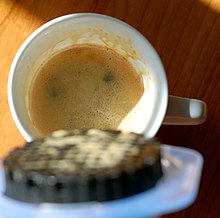AeroPress

The AeroPress is a device for brewing coffee. It was invented in 2005 by Alan Adler[1]. Coffee is steeped for about 10 seconds and then forced through a paper microfilter. The maker describes the result as an espresso strength concentration of coffee, but others consider it more like strong coffee [2].
The device consists of two polycarbonate cylinders. One cylinder has a rubber plunger and fits inside the larger cylinder to create an airtight seal, similar to a syringe. Fine-ground coffee is placed in the bottom of the larger cylinder on top of a paper microfilter. Hot water (approximately 170-190 degrees Fahrenheit or 75-80 degrees Celsius) is then poured over the coffee, this mixture is stirred and allowed to steep for approximately 10 seconds before being forced through the microfilter using air pressure generated by pushing the second cylinder downwards.[3].


AeroPress coffee properties
- Claimed to have roughly the same strength as espresso.[citation needed]
- Higher pH (less acidic) than drip coffee.[1]
- Low bitterness[citation needed].
- 30-second total brewing time.
Differences from French Press
Though similar to the French Press brewing method the AeroPress is quite different.
- Uses a disposable paper filter which removes most of the coffee oils.
- Air pressure is used to extract more coffee solids.
- Shorter brewing time.
- Tighter filtration resulting in a sediment-free brew.
- Uses more finely ground coffee.
- Shorter cleanup time.
References
- ^ a b Inventor brews a faster cup of good coffee Knight Ridder Newspapers
- ^ Aero Press Brew Instructions from Sweet Maria's
- ^ The AeroPress Story Official AeroPress Site
